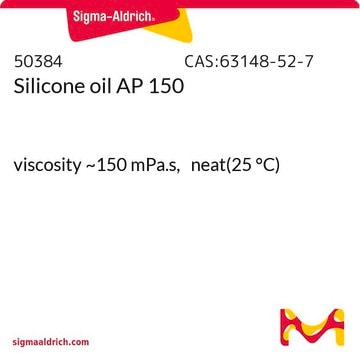146153
Siliconöl
for melting point and boiling point apparatuses
About This Item
Empfohlene Produkte
Dampfdichte
>1 (vs air)
Dampfdruck
<5 mmHg ( 25 °C)
5 mmHg ( 20 °C)
Typ
for melting point and boiling point apparatuses
Parameter
−40-350 °F temp. range (−40-175 °C)
Brechungsindex
n20/D 1.403 (lit.)
Viskosität
45.0-55.0(25 °C)
bp
>140 °C/0.002 mmHg (lit.)
Dichte
0.963 g/mL at 25 °C
Suchen Sie nach ähnlichen Produkten? Aufrufen Leitfaden zum Produktvergleich
Anwendung
- for melting-point and boiling-point apparatus
- in membrane contactors to impregnate fibers
- on rheometer samples (chicken skin and bovine gelatin) to prevent evaporation during heating using temperature sweeps and frequency sweeps
Biochem./physiol. Wirkung
Leistungsmerkmale und Vorteile
- High viscosity
- Low water solubility
- Low vapor pressure
Lagerklassenschlüssel
10 - Combustible liquids
WGK
WGK 1
Flammpunkt (°F)
214.0 °F - closed cup
Flammpunkt (°C)
101.1 °C - closed cup
Persönliche Schutzausrüstung
Eyeshields, Gloves
Choose from one of the most recent versions:
Analysenzertifikate (COA)
Don't see the Right Version?
If you require a particular version, you can look up a specific certificate by the Lot or Batch number.
Besitzen Sie dieses Produkt bereits?
In der Dokumentenbibliothek finden Sie die Dokumentation zu den Produkten, die Sie kürzlich erworben haben.
Kunden haben sich ebenfalls angesehen
Unser Team von Wissenschaftlern verfügt über Erfahrung in allen Forschungsbereichen einschließlich Life Science, Materialwissenschaften, chemischer Synthese, Chromatographie, Analytik und vielen mehr..
Setzen Sie sich mit dem technischen Dienst in Verbindung.






